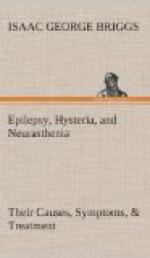Such a victim awakes confused, but imputes his mental sluggishness to a hearty supper or “a bad night”. A swollen tongue, blood-stained pillow, and urinated bed arouse suspicion as to the real cause, suspicion which is confirmed by a seizure during the day. He is more fortunate (if such a term can rightly be used of any sufferer from this malady) than his fellow victim whose attacks occur during the day, often under circumstances which, to a sensitive nature, are very mortifying.
Epileptic attacks are of every degree of violence, varying from a moment’s unconsciousness, from which the patient recovers so quickly that he cannot be convinced he has been ill, to that awful state which terrifies every beholder, and seems to menace the hapless victim with instant death. Every degree of frequency, too, is known, from one attack in a lifetime, down through one in a year, a month, a week, or a day; several in the same periods, to hundreds in four-and-twenty hours.
PETIT MAL ("Little Evil”)
This is incomplete grand mal, the starting stages only of a fit, recovery occurring before convulsions.
Petit mal often occurs in people who do not suffer from grand mal, the symptoms consisting of a loss of consciousness for a few seconds, the seizure being so brief that the victim never realizes he has been unconscious. He suddenly stops what he is doing, turns pale, and his eyes become fixed in a glassy stare. He may give a slight jerk, sway, and make some slight sound, smack his lips, try to speak, or moan. He recovers with a start, and is confused, the attack usually being over ere he has had time to fall.
If talking when attacked, he hesitates, stares in an absent-minded manner, and then completes his interrupted sentence, unaware that he has acted strangely. Whatever act he is engaged in is interrupted for a second or two, and then resumed.
A mild type of petit mal consists of a temporary blurring of consciousness, with muscular weakness. The victim drops what he is holding, and is conscious of a strange, extremely unpleasant sensation, a sensation which he is usually quite unable to describe to anyone else. The view in front is clear, he understands what it is—a house here, a tree there, and so on—yet he does not grasp the vista as usual. Other victims have short spells of giddiness, while some are unable to realize “where they are” for a few moments.
Frequent petit mal impairs the intellect more than grand mal, for convulsions calm the patient as a good cry calms hysterical people. After a number of attacks of petit mal, grand mal usually supervenes, and most epileptics suffer from attacks of both types. Some precocious, perverse children are victims of unrecognized petit mal, and when pushed at school run grave risks of developing symptoms of true epilepsy. The “Little Evil” is a serious complaint.




